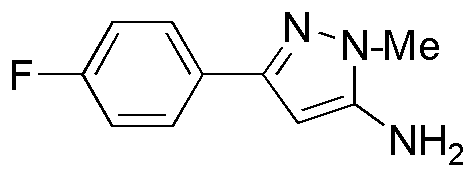5-(4-Fluorophenyl)-2-methyl-2H-pyrazol-3-ylamine is widely utilized in research focused on:
- Pharmaceutical Development: This compound serves as a key intermediate in the synthesis of various pharmaceuticals, particularly in the development of anti-inflammatory and analgesic drugs.
- Agricultural Chemistry: It is employed in the formulation of agrochemicals, helping to enhance crop protection against pests and diseases, thereby improving agricultural yields.
- Biochemical Research: Researchers utilize this compound in studies related to enzyme inhibition, contributing to the understanding of biochemical pathways and potential therapeutic targets.
- Material Science: It is explored in the development of novel materials, such as polymers and coatings, due to its unique chemical properties that can enhance material performance.
- Diagnostic Applications: The compound is investigated for use in diagnostic assays, potentially aiding in the detection of specific biological markers in clinical settings.
General Information
Properties
Safety and Regulations
Applications
5-(4-Fluorophenyl)-2-methyl-2H-pyrazol-3-ylamine is widely utilized in research focused on:
- Pharmaceutical Development: This compound serves as a key intermediate in the synthesis of various pharmaceuticals, particularly in the development of anti-inflammatory and analgesic drugs.
- Agricultural Chemistry: It is employed in the formulation of agrochemicals, helping to enhance crop protection against pests and diseases, thereby improving agricultural yields.
- Biochemical Research: Researchers utilize this compound in studies related to enzyme inhibition, contributing to the understanding of biochemical pathways and potential therapeutic targets.
- Material Science: It is explored in the development of novel materials, such as polymers and coatings, due to its unique chemical properties that can enhance material performance.
- Diagnostic Applications: The compound is investigated for use in diagnostic assays, potentially aiding in the detection of specific biological markers in clinical settings.
Documents
Safety Data Sheets (SDS)
The SDS provides comprehensive safety information on handling, storage, and disposal of the product.
Product Specification (PS)
The PS provides a comprehensive breakdown of the product’s properties, including chemical composition, physical state, purity, and storage requirements. It also details acceptable quality ranges and the product's intended applications.
Certificates of Analysis (COA)
Search for Certificates of Analysis (COA) by entering the products Lot Number. Lot and Batch Numbers can be found on a product’s label following the words ‘Lot’ or ‘Batch’.
*Catalog Number
*Lot Number
Certificates Of Origin (COO)
This COO confirms the country where the product was manufactured, and also details the materials and components used in it and whether it is derived from natural, synthetic, or other specific sources. This certificate may be required for customs, trade, and regulatory compliance.
*Catalog Number
*Lot Number
Safety Data Sheets (SDS)
The SDS provides comprehensive safety information on handling, storage, and disposal of the product.
DownloadProduct Specification (PS)
The PS provides a comprehensive breakdown of the product’s properties, including chemical composition, physical state, purity, and storage requirements. It also details acceptable quality ranges and the product's intended applications.
DownloadCertificates of Analysis (COA)
Search for Certificates of Analysis (COA) by entering the products Lot Number. Lot and Batch Numbers can be found on a product’s label following the words ‘Lot’ or ‘Batch’.
*Catalog Number
*Lot Number
Certificates Of Origin (COO)
This COO confirms the country where the product was manufactured, and also details the materials and components used in it and whether it is derived from natural, synthetic, or other specific sources. This certificate may be required for customs, trade, and regulatory compliance.

